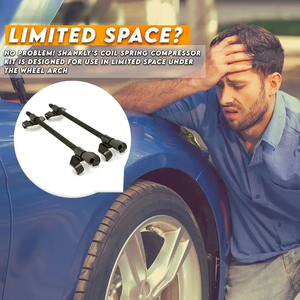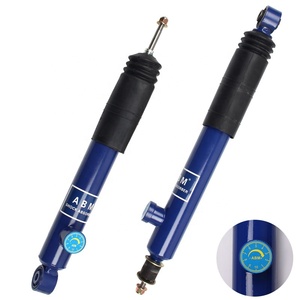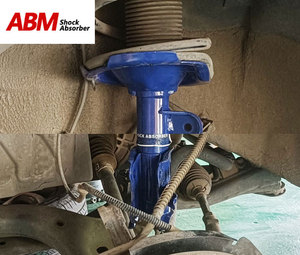(120 produk tersedia)










































































































































































































Sebuah **kompresor per suspensi motor** digunakan untuk menekan pegas koil pada peredam kejut. Ini memudahkan untuk melepas atau memasang peredam kejut. Ada beberapa jenis kompresor per suspensi motor, yang dibahas di bawah ini:
Kompresor Hidrolik
Jenis kompresor ini menggunakan tenaga fluida untuk menekan pegas koil. Ia memiliki tangki berisi fluida hidrolik dan pompa yang menghasilkan tekanan. Tekanan dan gaya fluida memungkinkan piston kompresor untuk bergerak dan menekan pegas.
Kompresor Batang Berulir
Kompresor batang berulir memiliki satu atau dua batang dengan ulir. Saat batang diputar, pegas akan tertekan atau mengembang. Pemutaran dilakukan menggunakan kunci pas pada takik di bagian atas pegas.
Kompresor Listrik
Kompresor listrik mendapatkan tenaganya dari motor listrik. Motor menggerakkan bilah kompresor untuk menciptakan aliran udara dan tekanan. Kompresor ini jauh lebih cepat daripada kompresor manual tetapi dengan harga yang lebih tinggi.
Kompresor Kerang
Kompresor ini memiliki dua bagian berbentuk kerang yang menyelimuti pegas. Mereka memiliki engsel di bagian belakang dan mekanisme pengunci di bagian depan. Kedua bagian kerang akan menutup dan membuka seperti kerang, memungkinkan pegas mudah tertekan dan dilepaskan.
Kompresor Kunci Pas Impak
Kompresor ini menggunakan kunci pas impak untuk memutar poros penggerak kompresor. Kunci pas impak menerapkan torsi tinggi dengan mekanisme palu putarnya. Ini memudahkan untuk menekan pegas yang besar atau berat.
Kompresor Per Garpu
Kompresor per garpu dirancang untuk bekerja pada pegas yang terdapat pada garpu roda depan. Seperti jenis pegas lainnya, per garpu dapat aus dan memerlukan penggantian. Motor tidak akan berjalan dengan baik jika per garpu tidak dalam kondisi baik. Kompresor per garpu memiliki batang dan klem. Mereka juga memiliki pegangan yang memudahkan penyesuaian dan pengoperasian.
Sebelum membeli kompresor per suspensi motor, penting untuk memahami spesifikasinya. Berikut adalah beberapa di antaranya:
Kapasitas Beban
Kapasitas beban kompresor per suspensi motor adalah total berat yang dapat diangkatnya. Angka ini penting saat bekerja dengan pegas yang berat. Kapasitas beban untuk sebagian besar kompresor adalah sekitar 400-600 lbs.
Panjang Tertekan
Panjang tertekan adalah total panjang kompresor saat pegas tertekan sepenuhnya. Pengukuran ini penting saat menyimpan alat di ruang sempit. Panjang tertekan pada sebagian besar kompresor adalah sekitar 18-22 inci.
Panjang Terentang
Panjang terentang kompresor per suspensi motor adalah total panjang saat pegas tidak tertekan. Pengukuran ini penting saat bekerja dengan pegas yang panjang atau lebar. Panjang terentang untuk sebagian besar kompresor adalah sekitar 28-32 inci.
Panjang Pegangan
Panjang pegangan adalah total panjang pegangan kompresor. Pengukuran ini penting saat menerapkan gaya untuk mengencangkan atau melonggarkan baut pegas. Panjang pegangan untuk sebagian besar kompresor adalah sekitar 6-8 inci.
Ukuran Ulir
Ukuran ulir pada baut kompresor harus sesuai dengan lubang pada peredam kejut motor. Sebagian besar baut kompresor dilengkapi dengan ukuran ulir 1/4-20 atau 3/8-16.
Kompresor per suspensi motor tidak memerlukan banyak perawatan. Namun, pengguna harus memeriksa dan membersihkannya secara teratur untuk memastikan umur pakai yang lebih lama. Berikut adalah beberapa tips perawatan:
Pembersihan
Setelah digunakan, kompresor harus dibersihkan untuk menghilangkan kotoran dan puing-puing. Sikat bulu lembut dapat digunakan untuk membersihkan bodi, serta klem pegas. Ini akan mencegah karat dan memastikan mesin bekerja dengan baik.
Pemeriksaan
Secara berkala, pengguna harus memeriksa kompresor per suspensi motor untuk melihat tanda-tanda kerusakan. Mereka harus memperhatikan klem dan bodi untuk bagian yang aus. Jika ditemukan kerusakan, pengguna harus mengganti atau memperbaiki mesin.
Pelumasan
Klem dan bodi kompresor per suspensi motor memiliki bagian yang bergerak yang membutuhkan pelumasan. Pengguna harus mengoleskan beberapa tetes oli setidaknya sebulan sekali untuk memastikan klem bergerak lancar.
Penggunaan yang Benar
Pengguna harus selalu mengikuti petunjuk pabrikan saat menggunakan kompresor per suspensi motor. Ini akan mencegah kerusakan pada alat serta peredam kejut motor.
Ada beberapa faktor yang perlu dipertimbangkan saat memilih kompresor per suspensi motor untuk dijual kembali, termasuk:
Reputasi Merek
Saat memilih kompresor per suspensi motor, pertimbangkan reputasi mereknya. Merek terkenal telah membangun reputasi untuk keandalan dan kualitas.
Kualitas dan Ketahanan
Kualitas dan ketahanan merupakan faktor penting yang perlu dipertimbangkan saat memilih kompresor per suspensi motor. Selalu pilih kompresor dengan konstruksi yang kokoh.
Harga
Harga adalah faktor penting yang perlu dipertimbangkan saat memilih kompresor per suspensi motor. Pilih kompresor yang terjangkau tanpa mengorbankan kualitas.
Kemudahan Penggunaan
Faktor lain yang perlu dipertimbangkan adalah kemudahan penggunaan kompresor. Pilih kompresor yang mudah digunakan dan dipahami, dengan petunjuk yang jelas.
Portabilitas
Portabilitas juga merupakan faktor penting yang perlu dipertimbangkan saat memilih kompresor per suspensi motor. Pilih kompresor yang mudah dibawa dan dipindahkan.
Kemampuan Beradaptasi
Pertimbangkan kemampuan beradaptasi kompresor sebelum memilih kompresor per suspensi motor. Pilih kompresor yang kompatibel dengan berbagai ukuran dan jenis pegas.
Fitur Keamanan
Selalu pertimbangkan fitur keamanan kompresor per suspensi motor. Pilih kompresor dengan fitur keamanan seperti kunci pengaman dan penutup pelindung.
Garansi
Pertimbangkan garansi saat memilih kompresor per suspensi motor. Pilih kompresor dengan masa garansi yang baik untuk melindungi investasi Anda.
Ulasan Pelanggan
Terakhir, pertimbangkan ulasan pelanggan sebelum memilih kompresor per suspensi motor. Baca ulasan pelanggan untuk mempelajari pengalaman pengguna lainnya.
Mengganti per suspensi dapat sangat berbahaya jika tidak dilakukan dengan benar. Pegas tersebut memiliki banyak tegangan, dan jika dilepaskan secara tiba-tiba, dapat menyebabkan cedera serius. Sebelum mencoba mengganti per suspensi, pastikan Anda memiliki pelatihan yang tepat. Hanya teknisi yang berkualifikasi yang boleh mengganti per suspensi. Jika pemilik memutuskan untuk melakukannya sendiri, pastikan untuk mengikuti petunjuk pabrikan dengan cermat.
Untuk mengganti per suspensi motor, pertama-tama lepaskan peredam kejut dari motor. Setelah itu, gunakan kompresor per suspensi motor untuk melepas pegas lama dengan aman dan memasang yang baru. Kemudian, pasang kembali peredam kejut dan pastikan bekerja dengan baik.
Berikut adalah panduan lengkap tentang cara mengganti per suspensi motor:
Siapkan Motor
Pastikan motor berada di permukaan yang rata. Gunakan dudukan paddock untuk menahan motor agar tidak jatuh.
Lepaskan Peredam Kejut
Lepaskan mur di bagian atas dan bawah peredam kejut menggunakan kunci pas dan soket. Kemudian, tarik peredam kejut keluar dari titik pemasangan.
Tekan Pegas
Gunakan kompresor per suspensi motor untuk menekan pegas. Tempatkan kompresor di kedua ujung pegas dan kencangkan sampai pegas saling menempel.
Lepaskan Pegas
Setelah pegas tertekan sepenuhnya, lepaskan penahan atas dan bawah. Kemudian, lepaskan pegas dari bodi peredam kejut.
Pasang Pegas Baru
Tempatkan pegas baru di atas bodi peredam kejut. Kemudian, pasang penahan dan gunakan kompresor untuk menekan pegas sampai pas. Pastikan untuk mengikuti rekomendasi pabrikan.
Pasang Kembali Peredam Kejut
Setelah pegas baru terpasang, pasang kembali peredam kejut dan kencangkan murnya dengan aman.
T1: Apa itu kompresor per suspensi motor?
J1: Alat yang membantu meningkatkan atau mengurangi tegangan per suspensi pada motor.
T2: Bagaimana cara kerja kompresor per suspensi motor?
J2: Kompresor bekerja dengan menggunakan keuntungan mekanisnya untuk menekan pegas bersama. Ini membuat diameter pegas lebih kecil, sehingga dapat muat di dalam peredam kejut.
T3: Dapatkah pemula menggunakan kompresor per suspensi?
J3: Ya, tetapi mereka harus membaca petunjuk pabrikan dan, jika perlu, meminta nasihat mekanik profesional.